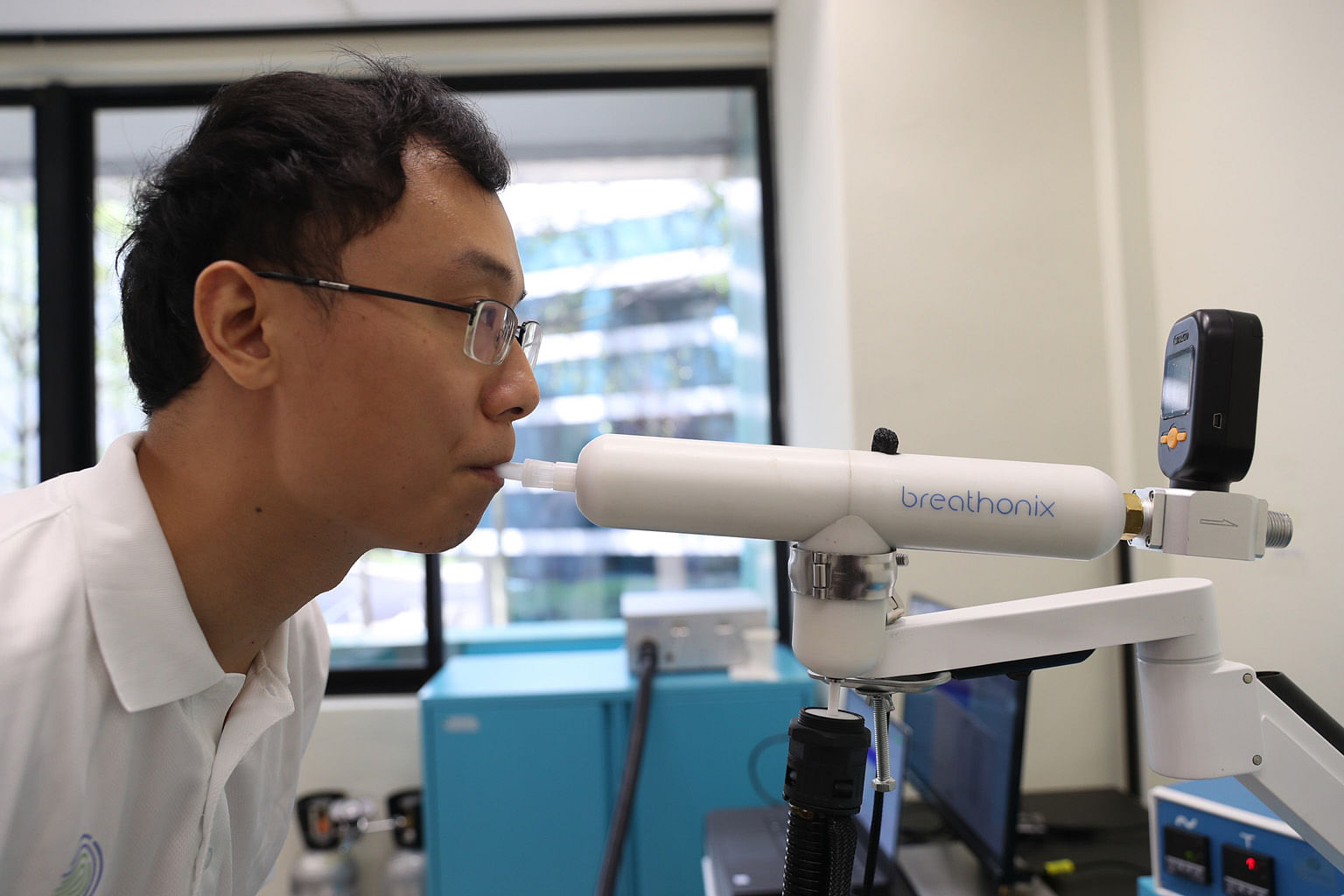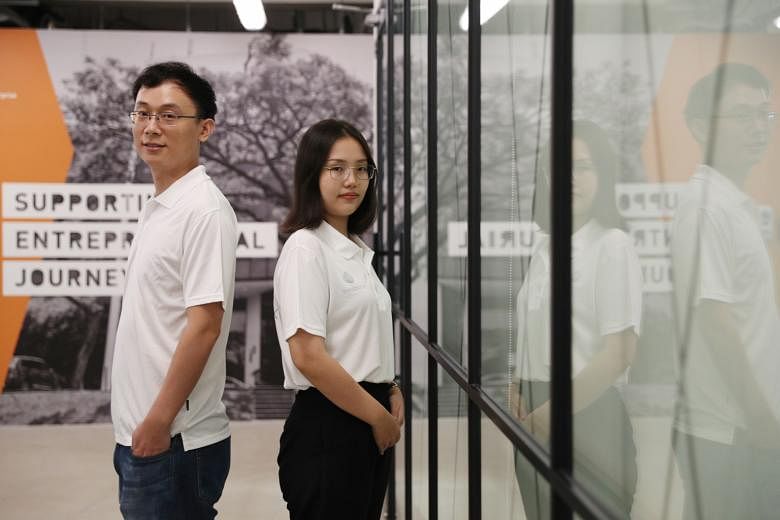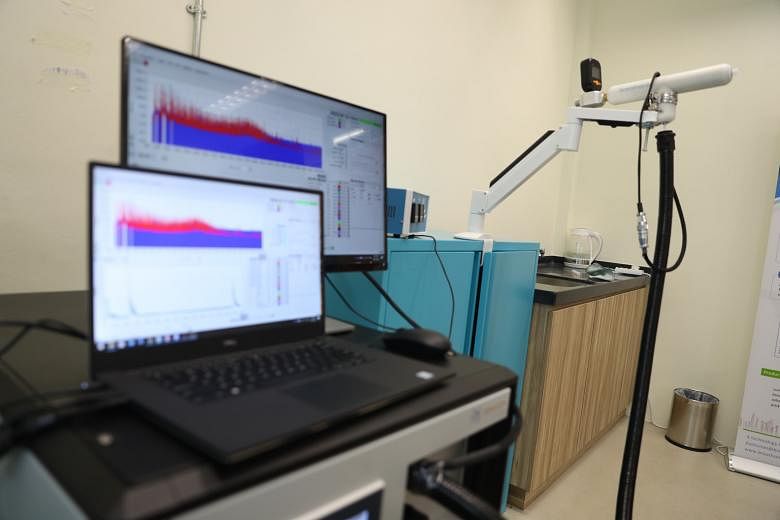Diagnosing a patient with Covid-19 could soon be as easy as getting the person to breathe into a tube - and getting the results in under a minute.
The breathalyser-type diagnostic test kit, which is still at a prototype stage, is being developed by Breathonix - a spin-off company from the National University of Singapore (NUS).
It has so far achieved an accuracy rate of more than 90 per cent during a pilot clinical trial involving 180 patients at the National Centre for Infectious Diseases (NCID), and researchers will continue to fine-tune the algorithm using data collected from the next phases of the trial.
The researchers are hoping to recruit up to 600 patients over the next few months to validate the technology.
Dr Jia Zhunan, an NUS graduate and the chief executive of Breathonix, is confident that the breath test could be a game changer in Singapore's fight against the coronavirus.
For one, the breath test is easy to administer, and does not require specially trained staff or laboratory processing usually required for polymerase chain reaction (PCR) tests.
''Results are generated in real time, making it an attractive solution for mass screening, especially in areas with high human traffic,'' Dr Jia added. These areas could include airports and dormitories.
The Breathonix test is unlike any other kits currently on the market in that it does not detect viral genetic fragments - which are what PCR tests pick up - or viral proteins, detected by antigen rapid tests.
Instead, it registers chemical changes in a patient's breath. Every exhale contains invisible particles known as volatile organic compounds (VOCs), which are produced by various biochemical reactions in human cells.
But the VOC signature from a healthy person's breath is different from that of a person with an illness. The breath signature also differs from disease to disease.
''This results in detectable changes in a person's breath profile,'' Dr Jia explained. ''As such, VOCs can be measured as markers for diseases like Covid-19.''
Currently, breath tests are already available to diagnose diseases such as asthma and Helicobacter pylori infection - a gastric disease.
The Breathonix test works by first getting a person to blow into a disposable mouthpiece connected to a high-precision breath sampler.
The exhaled breath is collected and fed into a cutting-edge mass spectrometer for measurement. Machine learning software analyses the VOC profile and generates the result in less than a minute.
Mr Du Fang, chief operating officer of Breathonix, said: ''The disposable mouthpiece that our sys tem uses has a one-way valve and a saliva trap, preventing inhalation and any saliva from entering the machine. This makes cross-contamination unlikely.''
Dr Shawn Vasoo, NCID clinical director, told The Straits Times that while the new breath test may serve as a screening test, a confirmatory PCR test will likely still be needed to diagnose Covid-19.
He said that although the breath test shows promise, more validation work needs to be done.
''It is still too early to compare VOC diagnostics to PCR, which is the current diagnostic 'gold standard', as more data is needed,'' Dr Vasoo added.
Breathonix was spun off from NUS under the NUS Graduate Research Innovation Programme last year, with the initial goal of using breath technology to diagnose patients with lung cancer.
Dr Jia, who completed her PhD research on breath VOC analysis for lung cancer, was inspired to enter the field after she came across a 1989 paper in the medical journal The Lancet.
The journal had reported on how a 44-year-old woman sought treatment for a lesion on her left thigh because her dog kept sniffing at it. The diagnosis was melanoma, a type of skin cancer, which was still treatable.
It prompted Dr Jia to think about how other illnesses could be diagnosed in this way. Lung cancer, which is often not diagnosed and progresses quickly, was one area Breathonix was focusing on.
But the Covid-19 pandemic has delayed plans to develop the technology for lung cancer.
Mr Du, however, saw an opportunity: ''retraining'' the algorithm to recognise the VOC signatures of Covid-19 patients. This was done based on data from 180 patients recruited from NCID, among whom 48 were Covid-19-positive and 132 negative.
Dr Vasoo said NCID hopes that new technologies which are rapid and provide real-time data may become available as an accurate screening tool for Covid-19.
''I think this would be welcome especially in specific settings where large numbers of people may need to be screened,'' he said, although there is no set timeline for this.
''A lot will depend on further validation work that many of us are busy with, which will help us to better assess its performance,'' he added.

Coronavirus breath test can get results in under a minute
A spin-off company from the National University of Singapore has developed a breathalyser-type diagnostic test kit that has so far achieved an accuracy rate of more than 90 per cent during a trial. The test works by getting a person to blow into a tube. The exhaled breath is then collected and measured.













